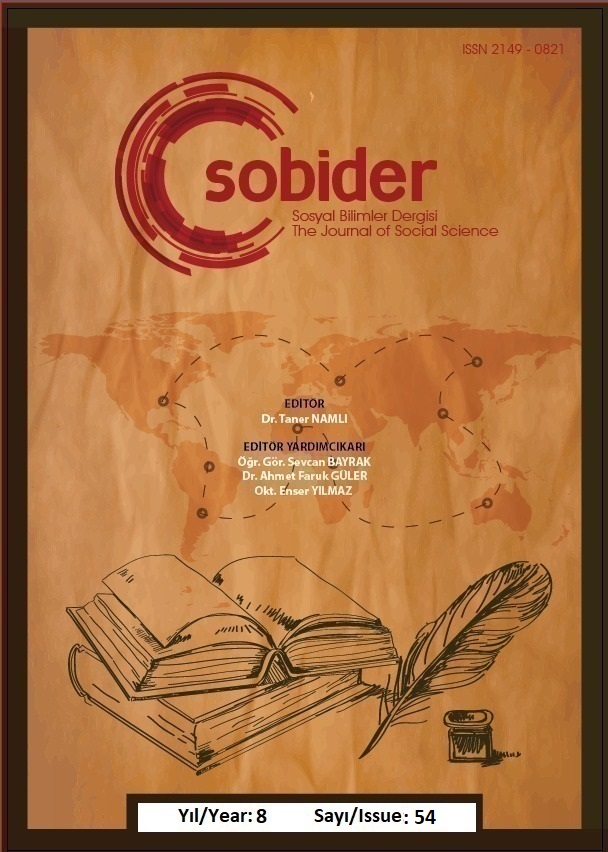SOSYAL BİLGİLER ÖĞRETMENLİĞİ ÖĞRENCİLERİNİN BASKIN ÖĞRENME STİLLERİNİN CİNSİYETLERİNE GÖRE İNCELENMESİ
Author :
Abstract
Bu çalışmanın amacı, sosyal bilgiler öğretmeni adaylarının bu öğrenme stilleri içerisinden tercih ettikleri baskın öğrenme stillerini belirlemek, cinsiyetlerinin ve öğrenim türlerinin öğrenme stillerine etkisini incelemektir. Son dönemlerde üzerinde yoğun olarak çalışılan ve öğrenme öğretme sürecinde son derece etkili olan değişkenlerden biri de öğrenme stilleridir. Öğrenme stillerini ele alan birçok öğrenme stili modeli bulunmaktadır. Temeli yaşantısal öğrenme kuramına dayalı Kolb Öğrenme Stili Modeli, yaygın olarak kullanılan modellerden biridir. Kolb öğrenme stili modelinde, ayrıştıran, değiştiren, özümseyen ve yerleştiren olmak üzere dört temel öğrenme stilinden söz edilmektedir. Araştırmada veri toplama aracı olarak Kolb Öğrenme Stili Envanteri kullanılmıştır. Çalışma grubunu (örneklem) 2014-2015 öğretim yılında Amasya Üniversitesi, İlköğretim Bölümü Sosyal Bilgiler Öğretmenliği Ana Bilim Dalı’nda okuyan toplam 80 öğrenci (rastgele)oluşturulmuştur. Örneklemin %50’si kız ve %50’si erkektir. Ancak cinsiyetin, tercih edilen öğrenme stiline etkisinin olmadığı bulunmuştur.
Keywords
Abstract
The aim of this study is to determine the dominant learning styles that social studies teacher candidates prefer among these learning styles, and to examine the effects of their gender and learning styles on learning styles. Learning styles are one of the variables that have been studied extensively in recent years and that have been extremely effective in the learning and teaching process. There are many learning style models that address learning styles. Kolb Learning Style Model, which is based on experiential learning theory, is one of the widely used models. In the Kolb learning style model, four basic learning styles are mentioned: converging, changing, assimilating and placing. Kolb Learning Style Inventory was used as a data collection tool in the research. The study group (sample) consisted of 80 students (randomly) studying at Amasya University, Department of Primary Education, Department of Social Studies Education in the 2014-2015 academic year. 50% of the sample is female and 50% is male. However, it was found that gender did not affect the preferred learning style.
Keywords
- Aktaş, İ.P. ve Mirzeoğlu, D. E. (2008). İlköğretim II. Kademe Öğrencilerinin Öğrenme Stillerinin Okul Başarılarına ve Beden Eğitimi Dersine Yönelik Tutumlarına Etkisi, Spormetre Beden Eğitimi ve Spor Bilimleri Dergisi, VII (1) 1-8
- Ateş, A ve Altun, E. (2008) Bilgisayar ve Öğretim Teknolojileri Eğitimi Öğrencilerinin Öğrenme Biçemleri ve Öğrenme Tercihleri, Eurasian Journal of Educational Research, 30, 1-16
- Aşkar , P. ve Akkoyunlu,B. (1993). Kolb Öğrenme Stili Envanteri, Eğitim ve Bilim. s. 87 ss:37-47.
- Bahar, H.H. Özen, Y. Gülaçtı, F. (2009). Eğitim Fakültesi Öğrencilerinin Cinsiyet ve Branşa Göre Akademik Başarı Durumları İle Öğrenme Stillerinin İncelenmesi Ankara Üniversitesi Eğitim Bilimleri Fakültesi Dergisi, cilt: 42, sayı: 1, ss.69-86
- Bahar, H.H. ve Sülün, A. ( 2011) Fen Bilgisi Öğretmen Adaylarının Öğrenme Stilleri Cinsiye Öğrenme Stili İlişkisi Ve Öğrenme Stiline Göre Akademik Başarı, Kastamonu Eğitim Dergisi.Cilt:19 no:2.ss. 379-386
- Büyüköztürk, Ş. (2014) Sosyal Bilimleri İçin Veri Analizi El Kitabı, İstatistik, Araştırma Deseni Spss Uygulamaları Ve Yorum. Genişletilmiş 20. Baskı. Anakara. Pegem akademi ss:21-40
- Çaycı, B ve Ünal E. (2007) Sınıf Öğretmeni Adaylarının Sahip Oldukları Öğrenme Stillerinin Çeşitli Değişkenlere Göre İncelenmesi Bilim, eğitim ve düşünce dergisi Cilt 7, Sayı 3, ss.1-16
- Demirkaya, H.,Mutlu,M. ve Uşak,M. (2003). 4Mat Öğretim Sistem Modeli’nin Çevre Eğitimine Uygulanması, Pamukkale Üniversitesi Eğitim Fakültesi Dergisi, Sayı:14
- Durukan, E. (2013) Türkçe Öğretmen Adaylarının Öğrenme Stilleri Ve Öğrenme Stratejileri Arasındaki İlişki, International Periodical For The Languages, Literature and History of Turkish or Turkic Volume 8/1 Winter 2013, p.1307- 1319, Ankara-Turkey
- Ekici, G. (2003).Uzaktan Eğitim Ortamlarının Seçiminde Öğrencilerin Öğrenme Stillerinin Önemi, Hacettepe Üniversitesi Eğitim Fakültesi Dergisi, 24:48-55
- Ergür, D.O. (1998). H.Ü. Dört Yıllık Lisans Programlarında Öğrenci ve Öğretim Üyelerinin Öğrenme Stillerinin Karsılaştırılması, Hacettepe Üniversitesi, Sosyal Bilimler Enstitüsü, Yayınlanmamış Doktora Tezi.
- Gencel, İ. E. (2006). Öğrenme Stilleri, Deneyimsel Öğrenme Kuramına Dayalı Eğitim, Tutum ve Sosyal Bilgiler Program Hedeflerine Erişi Düzeyi, Dokuz Eylül Ünv., Eğitim Bilimleri Enstitüsü, Doktora Tezi.
- Hasırcı, Ö. K. (2006). Sınıf Öğretmenliği Öğrencilerinin Öğrenme Stilleri: Çukurova Üniversitesi Örneği, Eğitimde Kuram ve Uygulama, 2 (1): 15-25
- Karasar, N. (2012). Bilimsel Araştırma Yöntemi, Nobel Yayınları, 23.Baskı, Ankara.
- Kılıç, E. (2002). Baskın öğrenme stilinin öğrenme etkinlikleri tercihi ve akademik Başarıya etkisi. Eğitim Bilimleri ve Uygulama, 1 (1): 1-15
- Kolb, D. A. (1984) Experiential Learning: Experiences as thesource of learningand development. Englewood Cliffs, N.J. :Prentice-Hall.
- McCarthy, B. (1987). The 4MAT System: Teachingto Learning Styleswith Right/LeftMode Techniques. Barrington: Excel Inc
- Merter,F. (2009) Cumhuriyet-Dicle-İnönü Üniversitesi Eğitim Fakültesi İlköğretim Bölümü Öğrencilerinin Öğrenme Stilleri Ve Öğrenme Stillerini Farklılaştıran SosyoEkonomik Faktörler, Dicle Üniversitesi Ziya Gökalp Eğitim Fakültesi Dergisi, 13, 78-96.
- Mutlu, M ve Aydoğdu, M. (2003) Fen Bilgisi Eğitiminde Kolb’un Yaşantısal Öğrenme Yaklaşımı, Pamukkale Üniversitesi Eğitim Fakültesi Dergisi Yıl:2003 (1) Sayı:13
- Numanoğlu, G. ve Şen, B. (2007) Bilgisayar Ve Öğretim Teknolojileri Eğitimi Bölümü Öğrencilerinin Öğrenme Stilleri, Ahi Evran Üniversitesi Kırşehir Eğitim Fakültesi Dergisi (KEFAD) Cilt 8, Sayı 2, (2007), (129-148) 129
- Uğur, B.(2007). Öğrencilerin Karma Öğrenme Yöntemine ve Yöntemin Uygulanmasına Yönelik Görüşlerinin Basarı, Cinsiyet ve Öğrenme Stilleri Açısından İncelenmesi, Hacettepe Ünv.,Fen Bilimleri Enstitüsü, Yüksek Lisans Tezi
- Uğur, N. (2008). Algısal Öğrenme Stilleri Açısından İlköğretim 4. Sınıf Sosyal Bilgiler Ders Kitaplarının ve Öğretmen Uygulamalarının İncelenmesi, Çukurova Ünv., Sosyal Bilimler Enstitüsü, Yayınlanmamış Yüksek Lisans Tezi.





